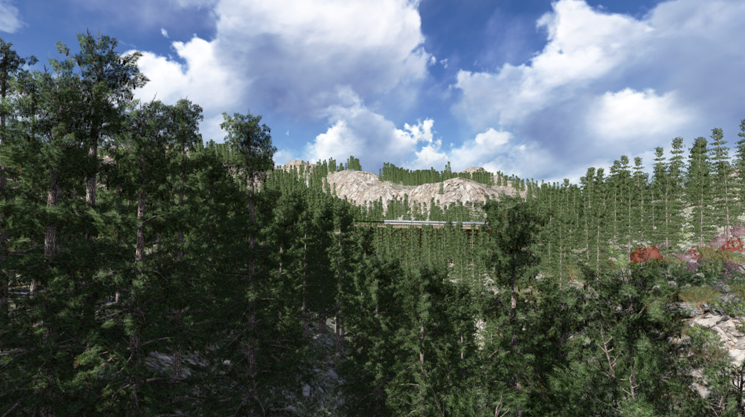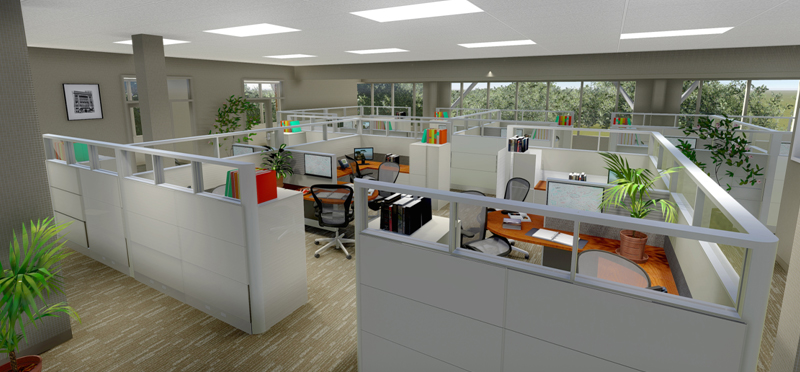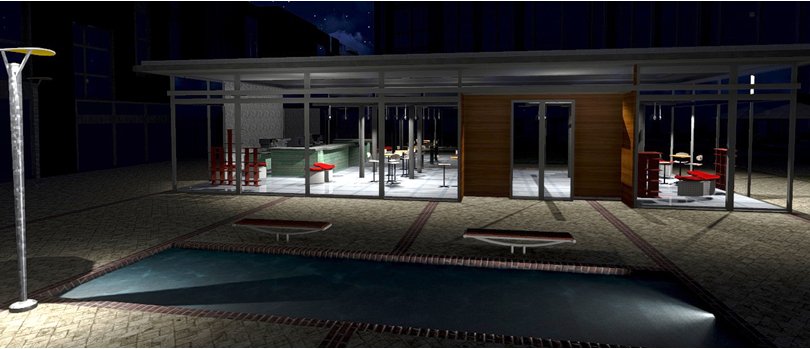
Advanced Motion Within Reach
Designers will drool over Lumion's professional-looking animation.
(Portions of this article appeared in the June 2013 issue of Landscape Architecture Magazine.)
3D animations are one of the most effective means to convey a design to a client, but producing high quality animations can be time consuming and expensive. Trimble SketchUp has tools for stringing scenes together to make movies, but it lacks the tools needed to create sophisticated, rendered fly-throughs. And other programs I’ve worked with can take days to create an animation. If there is a crash or error in the process, it can cause havoc. You could hire an expert to create the animation for you, but that would cost thousands of dollars for a 30-second clip. So, fancy animations are typically limited to big projects with large budgets.

Lumion allows you to effortlessly place thousands of vegetation objects into your models.
Lumion, by Act3D, could change that. It offers the designers and modelers a complete package of environmental rendering and animation tools with an array of options not available in other 3D rendering and animation software. The software is not cheap, but it is remarkably fast and easy to use.

Interior renders are easy to complete. Lumion uses real time lighting: place a light and watch it illuminate the scene instantly.
Lumion supports many file types: SketchUp, 3Ds Max, Revit, and more. I find that exporting your model as a Collada format from SketchUp will insure a seamless import into Lumion. Once your model is in Lumion you can do all sorts of things with it. You can play with different skies, clouds, and environmental effects such as fog. You can add real-time shadows, sun rays, and people and cars that actually move. The options are easy to implement, thanks to Lumion’s simple menus. You will not be faced with a bazillion options. I LOVE BAZILLION
A detailed texture menu comes preloaded with photorealistic effects. You can add realistic water that flows and glass that looks like glass. But what will really make you drool are the hundreds of objects optimized for the program. Using the object library, you can place different types of trees, shrubs, perennials, and evergreens. And you can add as many of these objects as you want. It seems to have no impact on performance.
Check out this animations created by Lumion Users:
Fazenda Dona Carolina’s animation, 50,000 trees: I have not counted every tree in the animation, but I would not be surprised if there were 50,000 in it. I can’t imagine doing that in many other programs:
The Water Street Animation by Vincent Hunter is detailed. Right down to the cats and pigeons:
Water Street 8-1-12 from Vincent Hunter on Vimeo.
And Lumion can be used and is ideal for small scale models like those create for residential design.
Part of the reason this is possible is the way the Lumion’s objects are optimized. When I’m planning to animate a model, I no longer put in any vegetation before I move the model to Lumion. It’s quicker to add these objects in Lumion, and vegetation imported from other programs will not be optimized in the same way.
When you add objects, Lumion will often randomize these objects for you. Every time you place a car, it changes the color automatically, allowing for greater variety. Vegetation habit and rotation can be further randomized for greater realism. Lumion also lets you model terrain. While you can’t grade your imported site with precision, you can edit, adjust, and sculpt surfaces in a variety of ways.
Lumion work flow is simple. Typically, it won’t take you more than an hour to add all the objects and adjust the textures, depending on the size of your site. A small residential plan can be completed in less than an hour, although a large master plan might take more time.
Once you have everything set and ready, you can produce snapshot images and animations. Select the Photo button at the right of screen. This opens a new menu that allows you to move the camera around the model and set your view. Click the snapshot button, and usually in less than a minute Lumion will export a smooth, crisp image. You can export your image in multiple resolution sizes and formats. There is no rendering time nor waiting. It’s that quick.
Select the Movie button at the right of the screen (below Photo) and Lumion transforms into an almost fully functional animation and effects studio. You will see a timeline filled with individual frames. Above the first frame are three options: Record, Image, and Movie from File. Record allows you to create a fly- through of the model; Image and Movie from File allow you to insert still images or other movies into the timeline. You can combine as many different animations, images, and other movie files into the timeline as you wish. The beauty of this system is that you can do quick, short recordings of specific parts of your model and Lumion will process the entire set into a single animation. You can also add a custom intro, sketches, project information, credits, and logos to your movie.
Hit Record to start making your fly-through, and Lumion will take you into a camera view of the model. Every time you take a photo, Lumion will add that scene to the Record sequence at the bottom of the screen. This establishes the path your fly-through will take. Hitting Play will animate the scenes in a smooth, seamless reel. In fact, it will seem as if a professional camera operator is controlling the camera progression, giving the animation a gentle acceleration and smooth movement like you see in an IMAX documentary. You can also speed or slow down the entire sequence. Clicking the up or down arrows above the Play button adjusts the speed of the animation. Based on this input, a little counter tells you how long the animation will be.
Lumion allows you to add a variety of different effects to your animations. You can show the landscape during different types of weather conditions. The snow will actually accumulate on your model surfaces and a light breeze will cause your vegetation to sway back and forth.
You can also have people, cars, and birds moving through the scene. These animation effects do take some time to master, but they’re not too difficult. Generally, you set the starting and end path for the selected objects and Lumion will do the rest. Lumion even lets you add sound effects, like a car engine or birds in flight. The program is not yet able to show people moving along a slope or descending a staircase, but a representative of ACT-3D says that this technically difficult feature might appear in future editions.
Lumion will not take long to generate the animation (which is an MP4 file). A typical HD animation (1280 x 720 resolution) can be produced in 2 to 10 hours, depending on the length of the animation and the graphics card used. This is incredibly fast in comparison to some other programs which take 20 to 30 hours if not days to process animations (not to mention the need for a render farm—sometimes 10 or more computers to help with the processing).
Once you prepare all the visual effects and sequences in Lumion, you can still return to your original model and make edits. For example, you can open your SketchUp model, make adjustments then re-export the model over the original exported version imported into Lumion. Lumion provides an option to update the model by re-sampling the exported file. All the objects, effects, animation sequences, and texture settings you already established are preserved. You do not have to redo all your work in Lumion.

Lumion’s real time lighting is amazing. This draft scene took minutes to set up and render
Lumion is not a low-cost software. Its price is $1,960 for the basic version or $3,922 for Lumion Pro. The main difference between versions has to do with the types of objects available. The standard version has fewer objects than the Pro version, which comes with a complete library of vegetation, people, and objects. Furthermore, Lumion Pro gets frequent updates that include new materials and objects. If you would like to try Lumion, there is a free version you can download; educational versions of the standard version are available for free; the Pro version is available through universities at a deep discount.
Before you invest in Lumion, it’s important to understand its hardware needs. Lumion requires a really good graphics card, as it relies on your graphics card for much of its processing. You will want a card with at least 1 gigabyte of memory (which is pretty standard on new computers these days). The more memory, the better. ACT 3D recommends at minimum the Nvidia GeForce GTX 460 or ATI 5850. It is worth obtaining the best possible card to work with Lumion. My system uses the Nvidia GeForce GTX 580, which makes a big difference.
Also, insure the graphics card is compatible with your computer if you plan on swapping it out. Some of these cards require more power than your computer may provide, so you’ll need to research it. You also need a minimum of 3 GB of RAM (6 GB is recommended). Don’t let any of this intimidate you, though. The animations you will be able to create are well worth it. Suddenly, you’ll find yourself doing animations for even small projects that don’t have gigantic fees.
A special thank you to Bill Brassch at Mundus Bishop and Rashad Al-ahamdi for sharing their experiences with USING Lumion.
Daniel Tal, ASLA, is a landscape architect and the author of two books on SketchUp: Google SketchUp for Site Design (August 2009) and Rendering In SketchUp (March 2013). Daniel is a partner at BrightmanTal (www.brightmantal.com)
Image Courtesy
Daniel Tal
www.danieltal.com
- Cover Story
-
 SketchUp Can Help You Win Interior..
SketchUp Can Help You Win Interior.. -
 Best Laptops for SketchUp
Best Laptops for SketchUp -
 How to Resize Textures and Materials..
How to Resize Textures and Materials.. -
 Discovering SketchUp 2020
Discovering SketchUp 2020 -
 Line Rendering with SketchUp and VRay
Line Rendering with SketchUp and VRay -
 Pushing The Boundary with architectural
Pushing The Boundary with architectural -
 Trimble Visiting Professionals Program
Trimble Visiting Professionals Program -
 Diagonal Tile Planning in SketchUp
Diagonal Tile Planning in SketchUp -
 Highlights of some amazing 3D Printed
Highlights of some amazing 3D Printed -
 Review of a new SketchUp Guide
Review of a new SketchUp Guide
- Sketchup Resources
-
 SKP for iphone/ipad
SKP for iphone/ipad -
 SKP for terrain modeling
SKP for terrain modeling -
 Pool Water In Vray Sketchup
Pool Water In Vray Sketchup -
 Rendering Optimization In Vray Sketchup
Rendering Optimization In Vray Sketchup -
 Background Modification In sketchup
Background Modification In sketchup -
 Grass Making with sketchup fur plugin
Grass Making with sketchup fur plugin -
 Landscape designing in Sketchup
Landscape designing in Sketchup -
 Apply styles with sketchup
Apply styles with sketchup -
 Bedroom Making with sketchup
Bedroom Making with sketchup -
 Review of Rendering Software
Review of Rendering Software -
 Enhancing rendering for 3d modeling
Enhancing rendering for 3d modeling -
 The combination of sketchup
The combination of sketchup -
 Exterior Night Scene rendering with vray
Exterior Night Scene rendering with vray





